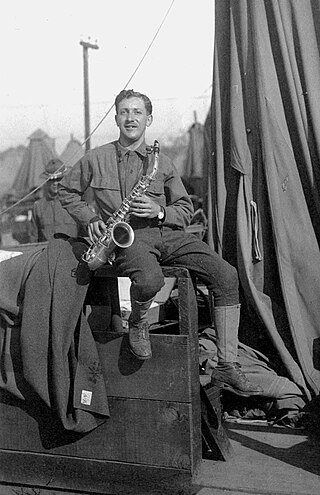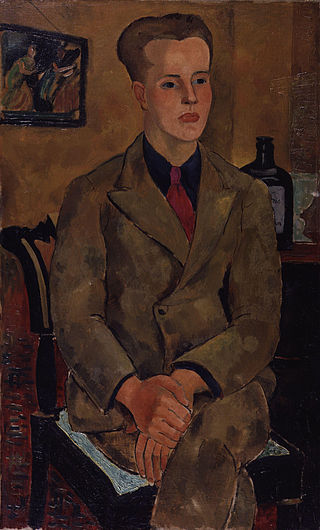
Kaintuck' (Kentucky) is a 1935 symphonic poem for piano and orchestra by American composer William Grant Still. [1]

Kaintuck' (Kentucky) is a 1935 symphonic poem for piano and orchestra by American composer William Grant Still. [1]
The work, written after being inspired by a train trip to Kentucky [2] and commissioned by the League of Composers, and originally scored for piano and symphony orchestra, was first performed on two pianos, with the composer's wife, Verna Arvey, as soloist, in Los Angeles on October 28, 1935 at a Pro Musica concert. Since then, the work has been played in a full orchestra version by Howard Hanson at the Eastman School of Music in Rochester, New York. [3] The work, dedicated to Still's wife ("To my wife, Verna Arvey"), [4] is about eleven minutes long.
A description of the symphonic poem is as follows:
[The work is] short and poetic ... It was written to express musically [Still's] inner reactions to the peaceful, shimmering, misty sunlight on the blue grass of Kentucky. It is a subjective not an objective picture ... Kaintuck' is built chiefly on two themes: everything else grows out of them. The piano opens the poem quietly, then runs into a rhythmic accompaniment to the orchestral statement of the themes. Both the piano and the orchestra are heard in huge, authoritative chords just before the cadenza by the solo instrument. This cadenza, unlike most, does not aim toward the exploitation of the interpreter, but simply and colorfully enhances the thematic and harmonic material that has preceded it. The theme is re-stated, and the piano closes the poem as quietly as it opened it. It is haunting, memorable. [3]
— Catherine Parson Smith, University of California Press
The sound of the steam locomotive can be heard in the piece. [5] [6]
Music reviewer Mary Carr Moore considered Kaintuck' a work of "real power and splendid proportions". [3] James Manheim of AllMusic writes that the work features "impressionist harmonies" and is "a gem". [7]

Ferdinand Rudolph von Grofé, known as Ferde Grofé was an American composer, arranger, pianist and instrumentalist. He is best known for his 1931 five-movement symphonic poem, Grand Canyon Suite, and for having orchestrated George Gershwin's Rhapsody in Blue for its 1924 premiere.

William Grant Still Jr. was an American composer of nearly two hundred works, including five symphonies, four ballets, nine operas, over thirty choral works, art songs, chamber music, and solo works. Born in Mississippi and growing up in Little Rock, Arkansas, Still attended Wilberforce University and Oberlin Conservatory of Music as a student of George Whitefield Chadwick and then Edgard Varèse. Because of his close association and collaboration with prominent African-American literary and cultural figures, Still is considered to be part of the Harlem Renaissance.

Howard Harold Hanson was an American composer, conductor, educator, music theorist, and champion of American classical music. As director for 40 years of the Eastman School of Music, he built a high-quality school and provided opportunities for commissioning and performing American music. In 1944, he won a Pulitzer Prize for his Symphony No. 4, and received numerous other awards including the George Foster Peabody Award for Outstanding Entertainment in Music in 1946.

Sergei Rachmaninoff's Piano Concerto No. 3 in D minor, Op. 30, was composed in the summer of 1909. The piece was premiered on November 28 of that year in New York City with the composer as soloist, accompanied by the New York Symphony Society under Walter Damrosch. The work has the reputation of being one of the most technically challenging piano concertos in the standard classical piano repertoire.
Concerto in F is a composition by George Gershwin for solo piano and orchestra which is closer in form to a traditional concerto than his earlier jazz-influenced Rhapsody in Blue. It was written in 1925 on a commission from the conductor and director Walter Damrosch. It is just over half an hour long.

Symphonic Dances, Op. 45, is an orchestral suite in three movements completed in October 1940 by Russian composer Sergei Rachmaninoff. It is his final major composition, and his only piece written in its entirety while living in the United States.
George Frederick McKay was a prolific modern American composer.

Afro-American Symphony, also known as Symphony No. 1"Afro-American" and Symphony No. 1 in A-flat major, is a 1930 composition by William Grant Still, the first symphony written by an African American and performed for a United States audience by a leading orchestra. It was premiered in 1931 by the Rochester Philharmonic Orchestra and later published in 1935. It is a symphonic piece for full orchestra, including celeste, harp, and tenor banjo. It combines a fairly traditional symphonic form with blues progressions and rhythms that were characteristic of popular African-American music at the time. This combination expressed Still's integration of black culture into the classical forms. Still used quotes from four poems by early 20th-century African-American poet Paul Laurence Dunbar as epigraphs for each symphonic movement. The symphony is about twenty-four minutes long.

Frederick Jacobi was a Jewish-American composer and teacher. His works include symphonies, concerti, chamber music, works for solo piano and for solo organ, lieder, and one opera.
Verna Arvey was an American librettist, pianist and writer who is best known for her musical collaborations with her husband William Grant Still, a musician and composer.

Troubled Island is an American opera in three acts composed by William Grant Still, with a libretto begun by poet Langston Hughes and completed by Verna Arvey. She married the composer following their collaboration.
The Symphonic Variations, M. 46, is a work for piano and orchestra written in 1885 by César Franck. It has been described as "one of Franck's tightest and most finished works", "a superb blending of piano and orchestra", and "a flawless work and as near perfection as a human composer can hope to get in a work of this nature". It is a fine example of Franck's use of cyclic unity, with one theme growing into various others. The piano and orchestra share equally in the development of ideas. The work is in F♯ minor. Duration in performance is about fifteen minutes, and the instrumentation is piano solo and orchestra: pairs of flutes, oboes, clarinets, and bassoons; four horns; two trumpets; timpani; and strings.

The Rio Grande is a secular cantata by English composer Constant Lambert. Written in 1927, it achieved instant and long-lasting popularity on its appearance on the concert stage in 1929. It is an example of symphonic jazz, not unlike the style of George Gershwin's Rhapsody in Blue, although it is very much Lambert's individual conception. It combines jazzy syncopation with lithe Latin American dance rhythms that create an air of haunting nostalgia. The Rio Grande takes roughly 15 to 20 minutes to perform. It was dedicated to Angus Morrison, who played at its first (broadcast) performance.

Miss Sally's Party is a 1940 ballet composition in eight-movements by American composer William Grant Still. A related libretto was written by Verna Arvey, wife of composer Still. The ballet was first performed on May 2, 1941, and is about nineteen minutes long.

Lenox Avenue is a series of ten orchestral episodes and a finale composed in 1937 by American composer William Grant Still. The composition is for orchestra, chorus and announcer; the narration was written by Verna Arvey, wife of composer Still. The first performance was broadcast nationally on radio on May 23, 1937, conducted by Howard Barlow. A related ballet version was composed in 1938, and is about twenty-one minutes long.

Symphony No. 2 in G minor, also known as Symphony No. 2"Song of a New Race", is a 1937 composition in four movements by American composer William Grant Still. The work was first performed on December 10, 1937, by the Philadelphia Orchestra led by conductor Leopold Stokowski. The symphony is about thirty minutes long.

Africa is a 1930 symphonic poem in three movements by American composer William Grant Still. The work, originally scored for chamber orchestra, was first performed in 1930 by French flautist Georges Barrère and, in a full orchestra version, by Howard Hanson on October 24, 1930, at the Eastman School of Music in Rochester, New York. The work is about twenty-eight minutes long.

Darker America is a 1924 symphonic poem by American composer William Grant Still. The composition, exploring themes of sorrow, hope, and prayer, is a work derived from Still's studies with the modernist composer Edgard Varèse. In the work, Still uses "melodic types found in African American music such as the descending melodic curve, the pentatonic scale of the spirituals, and the 'blues scales' of the blues. The primary harmonies used were the tonic, subdominant, and dominant harmony of the spirituals." The work was first performed by Eugene Goossens on November 22, 1926 at the Aeolian Hall in New York City, New York and is about twelve minutes long.

Three Visions is a 1935 suite in three parts for solo piano, and later, the second part, Summerland, for chamber orchestra, by American composer William Grant Still. According to Judith Anne Still, the composer's daughter, "The three segments of the suite, Dark Horsemen, Summerland, and Radiant Pinnacle, tell the story of the human soul after death: the body expires, and the soul goes on to an apocalyptic judgment. If it is seen that the past life has been a good one, the soul may enter “heaven,” or “Summerland”. After a period of time, the soul may reincarnate to learn additional earthly lessons on the human plane. Some souls reincarnate many times in a constant circular progress toward Godly perfection." Three Visions was composed by Still for his wife, Verna Arvey, who first played the composition in Los Angeles in 1936. The suite is about eleven minutes long.